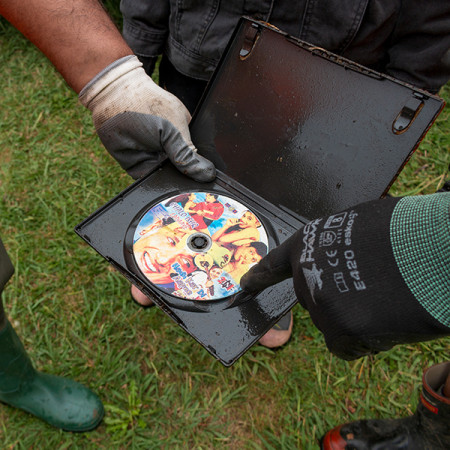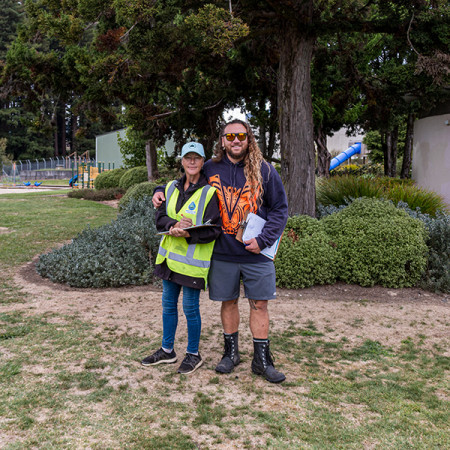"We need the river, and right now, the river needs us too."
– Tama Blackburn, Taiao Project Manager, Te Nehenehenui (TNN).

Can you recognise this ancient artefact?
“We need the river, and right now, the river needs us too,” read a passionate call to action from Tama Blackburn, Taiao Project Manager at Te Nehenehenui (TNN). Earlier this year, members of Waikato Regional Council’s Waipa river management team headed to Te Kūiti to lend a hand at the Mangaokewa ki Te Kūiti river clean-up day.
Led by TNN, the clean-up event brought together mana whenua/tangata tiaki, staff from Waikato Regional Council, Waitomo District Council, and the Department of Conservation, as well as tamariki and rangatahi from local schools, and passionate volunteers from the community. On the banks of the Mangaokewa, a small crowd gathered. Following karakia and a thorough health, safety, and tikanga briefing, the mahi got underway.
The volunteers were split into two groups: river crew and land crew. The small but mighty river crew consisted of experienced and keen kaimahi from WRC and DOC. The land crew tackled pest plants, unruly vegetation, and rubbish strewn along the riverbank. Aled de Malmanche, Waikato Regional Council’s river management lead for the Waipa zone, coordinated our response with Tama and liaised with WDC regarding their support. “It’s inspiring to see such dedication from everyone involved,” he says.
TNN reported that the event resulted in six loads of green waste (approximately 1600kg) and seven loads of domestic waste (approximately 1420kg) being successfully removed from the water and riverbanks. This included common items like shopping trolleys, road cones, and beer cans, as well as surprising finds such as two portable cassette players. Although it may be disappointing to learn that so much unwanted debris was in the awa (river) to start with, being able to assist in the safe removal has been rewarding for all involved. Not only did the team contribute physical mahi for the clean-up, but they also spent the day nurturing valuable connections with the local community and Waikato Regional Council’s Treaty partners in the Maniapoto area.
“It was fantastic to see so much support from many people and agencies, and a massive thanks to TNN for initiating this important mahi and coordinating the day,” says Paul Smith, Waikato Regional Council’s zone manager for Waipa and the West Coast.
But it was more than just the removal of eyesores like road cones or the beautification of overgrown riverbanks. This was a “communal clean-up of the life force that travels through Te Kūiti,” says Tama.

Michelle Wii and Tama Blackburn
The mauri of the river is crucial for Maara Kai Roopu-Maniapoto, a community garden that helps to feed people who need support from local foodbanks. Led by Michelle Wi, the flourishing initiative also provides educational opportunities to local schools, youth groups, and families to share knowledge about soil quality, seed preservation, growing, and harvesting kai. Michelle, who served as mana whenua liaison leader for the clean-up event, spoke of how caring for the wai is a crucial part of Maara Kai Roopu-Maniapoto’s mahi.
Earlier this year, Waikato Regional Council commissioned a survey to gather data on the channel and floodplain of the Mangaokewa Stream. Contractors from Beca recorded the ground and stream bed levels at historic stream cross-section locations through the Te Kuiti township. Around 20 cross-sections were completed, starting approximately 1km upstream of the township to 1km downstream of the town. Using the collected survey data, we will also be able to check, cross-reference, and incorporate the latest technology such as LiDAR (Light Detection and Ranging). Although LiDAR works well on land, this approach can’t pick up the stream bed level, which we need to know for channel capacity.
Surveying levels across the stream channel, including the associated floodplain/esplanade reserve, allows us to monitor the bed levels, stream conveyance, and capacity relative to original design. Following a condition inspection and report completed last financial year for the Mangaokewa through Te Kuiti township, physical works are underway to address issues identified such as pest willow control and blockage removal.
River Management
River management activities like these contribute to flood and erosion risk management by supporting and improving the natural capacity of rivers to retain and move water, reducing the frequency and impacts of flood damage. While landowners are primarily responsible for maintaining the riverbanks on their property, Waikato Regional Council supports these efforts through a River Management Programme in priority areas. This programme helps maintain river channel capacity, stabilise riverbanks, and improve fish passage and habitat.
This can be achieved through:
- Information and advice.
- Annual inspections of the main rivers and streams and responding to enquiries.
- Removal of obstructions within the channel that are causing or could increase the flood and erosion risk.
- Assisting with fencing off (for stock exclusion) eroding portions of channels.
- Planting and maintaining vegetation to help prevent erosion.
- Undertaking erosion control work within channels.
- Protecting Riverbanks
You can protect riverbanks from erosion by:
- Stock management – for example, fencing to keep stock out of rivers and other waterways.
- Planting the riverbank – for example, with natives.
Waikato Regional Council can work with you to deliver erosion protection (hard and soft engineering), in-stream capacity works (e.g., gravel management and obstruction removal), removal of trees that are at risk of falling and causing obstructions and erosion, planting of natives and willow poles to stabilise banks and improve biodiversity. These works increase ecological outcomes, ensure capacity within channels to cope in high rainfall events, keep streambanks stable, and reduce flooding impacts, protecting people and property.



To ask for help or report a problem, contact us
Tell us how we can improve the information on this page. (optional)